Neural DSP Quad Cortex: CorOS 3.3.0 brings mono synth, Neural Capture V2, and much more!
Also new: New captures, overdrives, and an improved preset system
Free major update for Quad Cortex and Nano Cortex! CorOS 3.30 brings several eagerly awaited features to the modelers. For example, the new Neural Capture V2 offers even better amp profiling, along with a guitar synth, a bitcrusher, and much more.
Details on the CorOS and Cortex Control update history
CorOS 3.3.0: Neural Capture V2, Bitcrusher, Synth, and tons of new captures!
The major new feature in CorOS 3.3.0 is Neural Capture V2. This is supposed to dramatically increase the accuracy and realism of profiled amps and pedals such as fuzz or compressors. It is worth noting, though, that because the captures are calculated in the Neural DSP cloud, an internet connection is required.
If you want to familiarize yourself with the quality of Neural Capture V2, you can do so with 669 new captures for amps, combos, and pedals. The update also includes 29 new effects and devices. One of the highlights is the new Mono Synth, which allows for guitar synth sounds. With this, we should not be far from getting Rabea X on the Quad Cortex.
Other additions include Dumbbell ODS (based on the Dumble Overdrive Special), Micro Processor (based on the Eventide Micropitch Delay), a bitcrusher engine, and Phase-Locked Loop (based on EarthQuaker Devices Data Corrupter). Neural DSP has also changed the preset system and sorted the captures into subcategories. As always, the update is free of charge for all Quad Cortex or Nano Cortex owners!

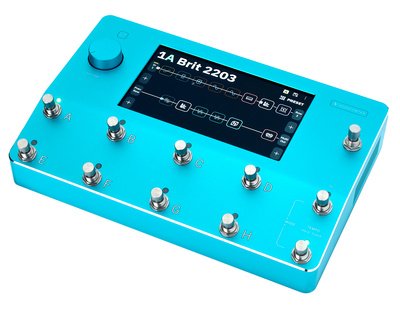

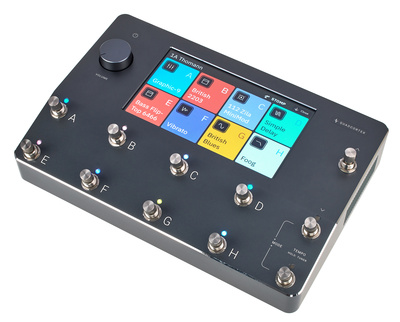

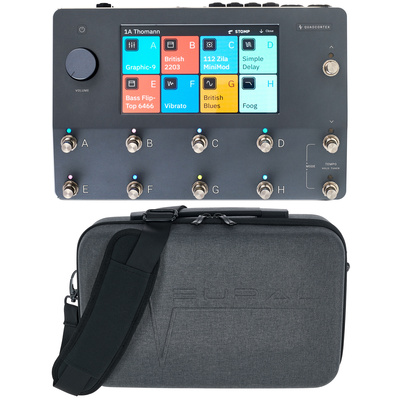

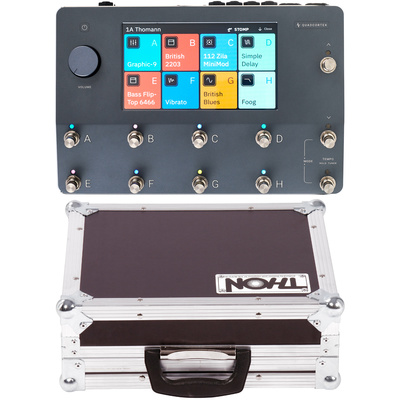
Special Thomann Edition in Blue!
[November 14, 2025] Following last year’s red Christmas edition of the Neural DSP Quad Cortex, this year’s color scheme is moving in the opposite direction. This year’s exclusive special edition at Thomann is light blue. Only for a limited time!
Blue Quad Cortex: Thomann Special Edition 2025
This version of the Neural DSP Quad Cortex is a real eye-catcher. The special edition*, available exclusively from Thomann, is now available for €1,585.00, while supplies last!




[August 8, 2025] Another mighty update for the Quad Cortex! With CorOS 3.2.0, Neural DSP integrates useful features such as a metronome and a live tuner, as well as additional support for its own software amps. Plus, the looper has been improved!
What’s new in CorOS 3.2.0 and Cortex Control 1.3.0
To start with, Neural DSP is expanding support for additional software amps this update. CorOS 3.2.0 now also supports Archetype: Cory Wong X, Archetype: Nolly X, and Parallax X in the Quad Cortex. We’re getting there!
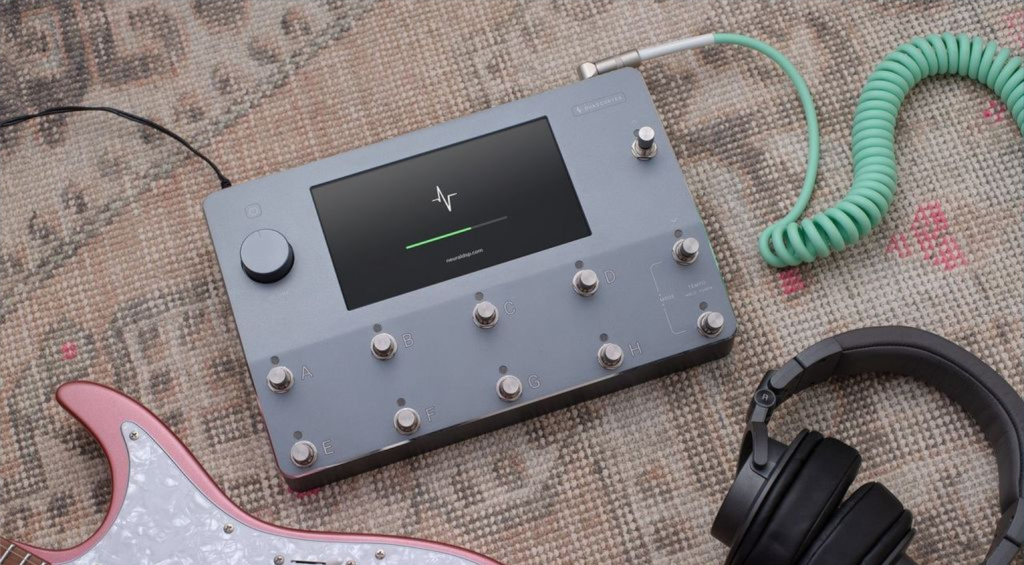
Also new: a metronome. This means you always have the click track with you, making practicing easier, and playing live, too. A live tuner has also been integrated, so you can see on the display whether your guitar is still in tune. Furthermore, the integrated looper has been improved.
The new pre-roll function allows you to set the number of bars after which the looper jumps into record or playback mode. You can now also set the loop length between one and 32 beats and assign various looper actions such as record, playback, or stop to the footswitches. Many other minor improvements and bug fixes are also included.
And with the new version 1.3.0, the desktop software Cortex Control now automatically imports user-generated impulse responses when importing presets. If you don’t own a Quad Cortex yet, you can find the flagship model at Thomann*!


Neural DSP Quad Cortex: Cortex Control 1.2.0, CorOS 3.1.0 with Preset Import
[12 December 2024] While the big update to CorOS 3.0.0 finally brought us the long-awaited support for plugins, Neural DSP wasn’t done yet. And today, they’re releasing a free update with new versions of both Cortex Control (1.2.0) and CorOS (3.1.0). In addition to extended support for plugins from Neural DSP, there are also a couple of new features and effects!
What’s included in CorOS 3.1.0 and Cortex Control 1.2.0?
First of all, the update is free for all Quad Cortex owners. CorOS 3.1.0 adds new features. For example, you can now directly drag and drop presets from supported software effects like Plini X and Archetype: Gojira X directly into CorOS 3.1.0. You can also bulk edit some parameters such as names, neural captures or IRs.
In addition, more Neural DSP plugins are now supported on the Quad Cortex: SLO 100 X and Fortin Nameless X. Both are reworked X versions of the older versions. If you own a license to the original, you get the new version for free, as well as the activation on the Quad Cortex.






Neural DSP Quad Cortex Limited Christmas Edition in Red!
[18 November 2024] Christmas is coming! And to celebrate it accordingly, Neural DSP is releasing a Quad Cortex in festive red – available from Thomann!
As far as we can see, this Neural DSP Quad Cortex limited edition seems to differ from the normal version in purely visual terms. It’s still the same powerful stomp modeller, not additional effects or amps added. So, if you’re feeling festive, you can celebrate that with a Quad Cortex in Christmas-themed (or rock ‘n roll) red with gold-colored foot switches. At Thomann* you can get this version for 1,585 euros, so it costs exactly the same as the normal edition.

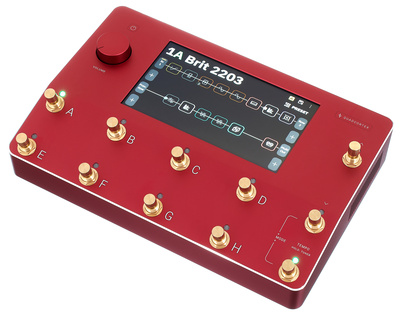
Firmware Update
[04 January 4 2024] The new Neural DSP Cortex Control is officially out now, along with CorOS 2.3.0, and lets users manage every feature and setting of the Quad Cortex.
UPDATE 04/01/24
The full version of Neural DSP’s Cortex Control is now officially available to download. The software is free for owners of the Quad Cortex and is available on MacOS and Windows platforms.
This software allows basic control, editing, and management of the Quad Cortex and simplifies the process of backing up. It is a neat way of optimising workflow and should make using the whole system a lot simpler for many users.
Neural Capture
It can also be used to do bulk actions, plus it offers streamlined importing of Impulse Responses and easy creation of Neural Captures. This is handled by allowing Cortex Control internet access via USB.
They have also added the Live Tuner feature, allowing for tuning as required.
Well worth downloading for any Quad Cortex owners and it is available for free from this link.
CorOS 2.3.0
CorOS 2.3.0 has also been officially released along with the Cortex Control. It adds some new features and fixes some previous bugs in the system. Notable new features include MIDI Clock Out, Pinned Devices, the new Made by Me’ Filter added to the filter section, Stomp Mode Bypass Assignment, Swap Tempo and Tuner Access, Reset Menu, and Reset Settings Option.
Along with a UI overhaul of the Graphic-9 EQ which also adds the following;
- HPF parameter value range is now OFF-500Hz.
- Added an LPF parameter to the second tab of parameters.
- The legacy Graphic-9 EQ device can be accessed through the Graphic-9 EQ parameter editor contextual menu.
Plus, the aforementioned bug fixes. As ever back up your system and follow the Neural DSP instructions before attempting the CorOS 2.3.0 update.
Cortex Control
Neural DSP has been teasing the Cortex Control for some time now and today it finally went into being downloadable as a Beta.
Edit and more
It means Quad Cortex users can now edit, backup, share, and play with all the parameters of the virtual amp and effects floor unit.
This is what users have been asking for and it will make Quad Cortex even more accessible for new and existing users.
Internet Access
Plus, Quad Cortex can now access the internet using the USB cable it’s connected to a computer with a connection. Making it easy to share and backup patches and tones.
No more relying on just the Quad Cortex’s built-in Wi-Fi.
Cortex Cloud
Users can also add IRs to their Quad Cortex or the Cortex Cloud profile via Cortex Control. The whole system has been designed to be easy to use and simple to navigate.
Easy To Use and Price Drop
I would expect this new software to really open up the Quad Cortex for a lot of users and make it more appealing to any potential new owners.
Users will need to update the firmware on their Quad Cortex with the latest CorOS 2.2.0 to use the new software.
The ease of use for editing and sharing, combined with the recent price drop of the Quad Cortex itself could well be a winning combination for Neural DSP.
Users can download the new free Beta for Windows and Mac here.
Neural DSP Quad Cortex 2.0 update
[28 January 2023] Neural DSP has added a new Quad Cortex 2.00 update that they state focuses on assignability, access, control, search, and cloud connectivity. It also adds just under 900 new Neural Captures to the popular modelling system.
Quad Cortex 2.00
This new Quad Cortex 2.00 update adds quite a lot of small refinements and you can see the full list here.
Plus, the added Hybrid Mode allows users to combine various modes together and then assign a particular mode to each row of footswitches. That also means that players can choose between modes easily and remove any they no longer require.
A global EQ is now available on Output 1/2 and Output 3/4, this adjustment is available from the I/O Settings.
There is a also new global bypass of Cabs, IR Loaders, and Neural Captures of cabs on any of the rows.
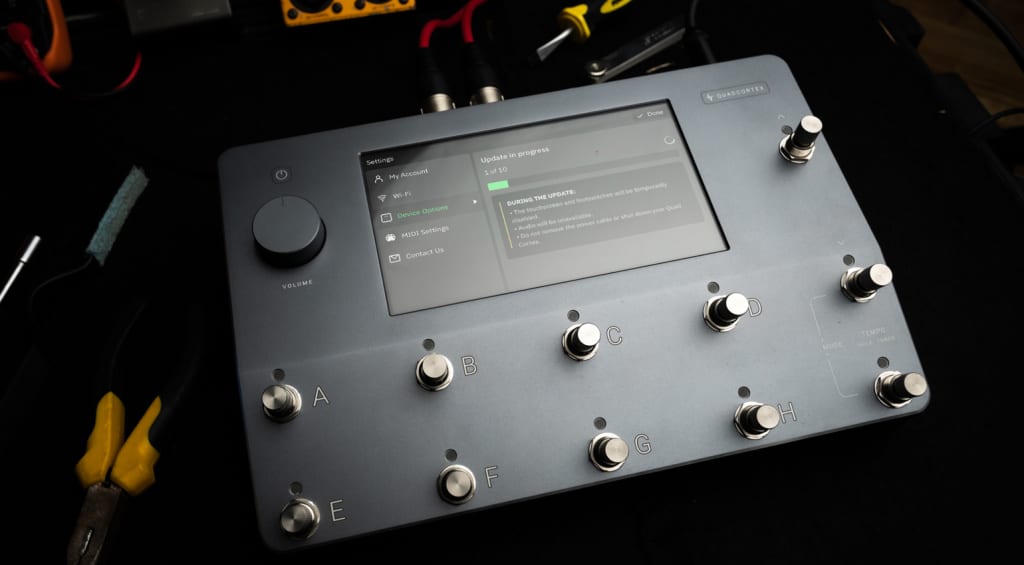
Directory
The Directory has been overhauled and offers improved management and organisation. This should help when locating Presets, Captures, IRs, etc. Each has its own category and these categories can be collapsed or expanded as needed.
Banks have been removed from Neural Captures, these are now replaced with a new sorting and filtering system, which in theory, should be easier to navigate. Plus, there is now a new Search facility to aid this.
The number of Captures that can be stored in the My Captures folder has also been doubled to 2048.
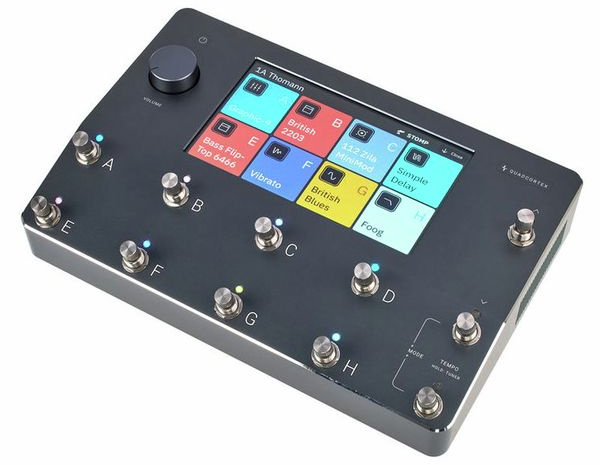
Neural Captures
Then there are the nearly 900 new Neural Captures which add a host of new gear for you to play with. This makes this a pretty large update for existing owners and anyone thinking of investing in a Quad Cortex for their rig.
Check the official 2.00 video below for an in-depth walk-through of all the newly added features and enhancements. Or follow this link to read the full extensive list in detail.
MSRP – EUR 1849 *






Neural DSP Quad Cortex CorOS 1.4.0 update adds Minivoicer and more
[24 June 2022] The latest Neural DSP Quad Cortex CorOS 1.4.0 update adds Minivoicer, nine new amplifiers and a host of new effects. Making the Quad Cortex even more appealing to potential new owners and making it even more fully-fledged.
Neural DSP Quad Cortex CorOS 1.4.0
The Neural DSP Quad Cortex CorOS 1.4.0 update adds 9 new amplifiers, 10 new effects and more routing options to the already powerful floor modeller.
Nine Amps
CorOS 1.4.0 includes the new Bogna Uber Clean and Lead, these are modelled after the Bogner Überschall Rev. Blue’s Clean and Lead channels. Three D-Cell Hisbert channels are based on channels 1-3 of the Diezel Herbert. Plus, the US HP Tweed TWN Bright, Bright Jumped, Normal, and Normal Jumped are all modelled on a Fender High Power Tweed Twin 5F8-A.
Ten Effects
It also adds three new overdrive models: Nobels ODR-1, Keeley Red Dirt, and the Vemuram Jan Ray. Plus a Dual Delay and five new compressor models, including Neural DSP’s versions of the Boss CS-3 and the Universal Audio 1176. They have also managed to squeeze in emulations of the Boss DC-2W, the MXR Phase 95 and a Dunlop Cry Baby.
Minivoicer
Then there is the new Minivoicer algorithm that allows users to add two pitch-shifted voices on top of their signal. It has controls so players can control the root note and modes. Allowing the Minivoicer to add some very handy harmonising and arpeggiating options. Plus, when connected via MIDI it will also harmonise over chord changes.
Tweaked System
There have been lots of tweaks to the overall system, including Stomp Mode Bypass, Input Gate, Boot Splash Screen, Recovery Mode and Swap Scenes, etc.
I also like that it now allows users to change which USB ins/outs send the dry or wet signal when you are using the Quad Cortex as an audio interface. Check out the official Deep Dive video below to hear the new Neural DSP Quad Cortex* CorOS1.4.0 update in action.
Get a looper for your Neural DSP Quad Cortex with new CorOS 1.3.0 update
[08 February 2022] The latest Quad Cortex CorOS 1.3.0 adds nine new amp models, including Marshall Silver Jubilee and Vox AC15-inspired models, three new cabinets and, most importantly, a looper with over 4 minutes of looping time. This should be more than enough recording time for most players out there.
Quad Cortex CorOS 1.3.0
The new CorOS 1.3.0 update for the Neural DSP Quad Cortex adds the ability to use a looper in Preset, Scene and Stomp modes, with 4 minutes and 44 seconds record time. Plus, it can be placed anywhere on The Grid, allowing users to get really creative with their looping. It will also remain active through Preset changes, as long as each individual Preset has a Looper block attached to it.
Record, Overdub, Play/Stop and Undo
The new looper has controls for Record, Overdub, Play/Stop and Undo, so it should be a breeze to use. And to hear it in action, check out the Mike Dawes demo video below. Reverse and Half Speed controls are also available, so it is pretty comprehensive. You also get Duplicate, which extends your original loop by any desired length, and One Shot, for one-repeat-only. The Re-Loop can trim the length of your initial loop recording.
Finally, you have a Quantise option that syncs the loop to the Quad Cortex internal tempo, MIDI compatibility, and a Threshold level that triggers the looper when an audio signal is detected.
Amps and Effects
This already is a massive update for anyone that was missing a looper function. But Neural DSP has also included nine new amp models, and three new virtual cabinets, so it’s quite a decent upgrade for owners of the Quad Cortex. On top of all this, there are new modulation effects and delays to play with. You can see all the new updated amp/cab and effects models in the official list below.
Official Amplifier List
- Brit UBL Lead (Marshall Silver Jubilee)
- Brit UBL Lead Clip (Marshall Silver Jubilee)
- UK C15 Boost (Vox AC15)
- UK C15 Normal (Vox AC15)
- US Prince (Fender Blackface Princeton Reverb)
- US Tweed Basslad Bright (Fender Bassman Tweed)
- US Tweed Basslad Bright Jumped (Fender Bassman Tweed)
- US Tweed Basslad Normal (Fender Bassman Tweed)
- US Tweed Basslad Normal Jumped (Fender Bassman Tweed)
Cabs
- 110 US PRN C10R (Fender Princeton with Jensen C10R drivers)
- 112 UK C15 Blue (Vox AC15 with Celestion Alnico Blue drivers)
- 410 US Basslad PR10 (Fender Bassman Tweed with Jensen P10R drivers)
Delay
- Analog Delay
- Analog Delay (Mono)
- Slapback Delay
- Slapback Delay (Mono)
Modulation
- Chief CE2W Chorus (BOSS CE-2W)
- Chief CE2W (Mono) (BOSS CE-2W)
- Chorus 229T (TC Electronic TC-2290)
- Chorus Engine
- Dream Chorus (TC Electronic Dreamscape)
- Dream Chorus (Mono) (TC Electronic Dreamscape)
- Flanger Engine
- MX Flanger (MXR Flanger M117R)
Neural DSP Quad Cortex
The Helsinki based company Neural DSP claims its Quad Cortex is “the most powerful floor modeler on the planet”. The unit is based around the 2GHz Quad-Core SHARC architecture, and this dedicated DSP is essentially the heart of the unit, providing it with a lot of realtime processing power. Add to that a 7” multi-touch display and it should also make the Quad Cortex super simple to navigate for users. It even has a built-in WiFi module that can be used for wireless preset sharing, or cloud backups, over-air firmware updates, and more.
The modeller comes with over 50 amps, 70 effects, and 1000 IRs, so there should be plenty to keep you occupied and up and running. You get 11 footswitches on the front and one big Volume dial. The footswitches can also be used to control virtual knobs on the amp and effects models, by turning them to adjust the parameters. Combine this with that massive touch screen, and this should be a breeze to use.
The floor unit itself has a robust anodised aluminium unibody, and at only 1.9 kg, is lightweight and portable, but also very strong. You should have no issues transporting it to gigs and rehearsals, and it should be able handle the rigours associated with the road.
Neural Capture
Capture, share, and download any rig’s sounds using the Neural Capture function. Neural DSP is using its own biomimetic AI technology which allows the Quad Cortex Limited Christmas Edition to learn and replicate the sonic characteristics of any physical amplifier, overdrive, or cabinet. This is what the company hopes will set it apart from its competitors. And if it works, it could put them way ahead of the competition.
IRs and EQ
With over 1000 impulse responses at your disposal, plus a parametric EQ, this unit should have enough ways for you to tailor your virtual rig. However, if you need more, then it can also handle any third party IRs you want to add to it.
I/O
With a pretty extensive input and output section, the Quad Cortex has you covered for just about every scenario when it comes to plugging your gear in and out of the unit. All the inputs and outputs are high-quality Neutrik parts where appropriate. So again, it is built to tour with.
It features dual combo inputs, with TS, TRS, and XLR. You also get variable impedance and level controls, with built-in microphone preamps and phantom power. A dual effects-loops can handle external mono or stereo effects in your signal chain.
For outputs, you have two mono, balanced (TRS) jacks along with two mono, balanced XLR output jacks, and a headphone output. Capture Out is used for the biomimetic AI technology, Neural Capture function. The unit also has MIDI In, Out/Thru, and dual expression inputs for two expression pedals, along with USB for any firmware updates, etc.
Neural CNS Mobile & Cortex Desktop Controller
You can explore and share your presets on the cloud with the Neural CNS Mobile, which syncs up to your device using the Quad Cortex’s built-in WiFi module. Once synced, you can send presets to and from your device with no cables involved, making back-ups or adding new sounds to your unit, a hassle-free process. The Cortex Desktop Controller then allows you to control the floor unit in real-time. Or you can use it to access the Neural CNS which is used for exploring, sharing, and downloading presets.
Switching Modes
There are three main switching modes available for users: Stomp Mode allows you to assign and activate any block in a rig to a footswitch, just like you would with a normal pedal board. Scene Mode lets you easily select any footswitch, and instantly activate it and control the settings of any number of blocks within a rig. Finally, with the Scene Mode, you can choose any footswitch to instantly activate and control the settings of any number of blocks within a rig.
Setlists and Gig View
The Quad Cortex uses Setlists to make the various Presets easy to organise. Simply put, you make your sets and then access them. Each Setlist can contain 32 banks of 8 Presets, which should be plenty for most players. The Gig View will let you see all three Stomp/Scene/Preset modes, making it even easier to see what’s on the display when you’re standing above the unit. Gig View uses the whole 7″ screen and shows you what is assigned to each footswitch.
Out Soon
It looks like the new Neural DSP Quad Cortex Limited Christmas Edition could well be the latest must have all-in-one floor modeller. Shipping is expected to start between the end of October and beginning of November, and I for one, am really looking forward to hearing it in action, as on paper it sounds pretty amazing.
You can follow the link below to read the full specification and and hear it in action in the demo video below.
NAMM 2020: Neural DSP launch Quad Cortex amp modelling pedal with machine learning
[10 January 2020] The new flagship Neural DSP Quad Cortex amp-modeller and multi-effects unit, has insane processing power and uses machine learning to get you awesome guitar tones.
Welcome To The Machine
Once upon a time us guitar players had an amp, ideally a valve one and possibly a few effects pedals to add a dash of colour to our guitar tone. Nowadays, the thing to rock out with is a little black floor pedal that uses DSP to give you all the tones you could ever dream of and more.
That is where the new Neural DSP Quad Cortex is firmly seated and it even uses machine learning to create its unique modelling sounds. The Helsinki based company is already well known for their software emulations and now at Winter NAMM 2020 they take their first tentative steps into high end hardware.
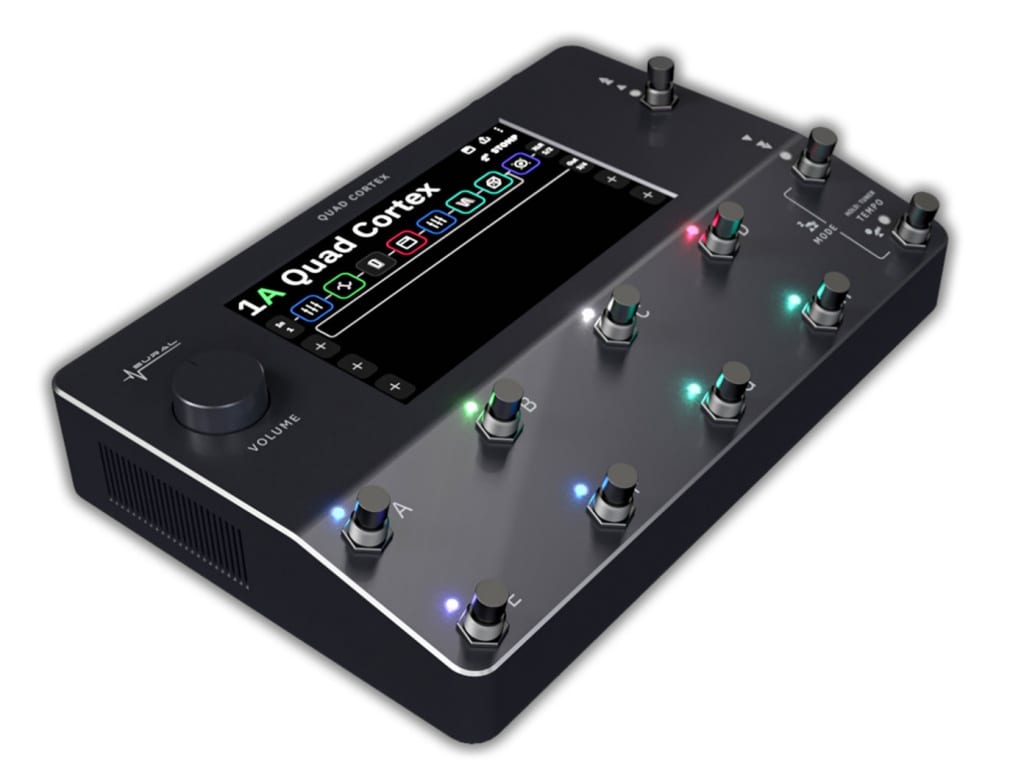
Access More
They even have a Cortex Desktop Controller allows you to control the floor unit in real-time via your PC/Mac or you can access more patches via the cloud, with the Neural CNS Mobile smartphone app.
Making it easy to integrate into your existing technology and potentially easier to visually edit and share your patches as well. Which, is always a nice thing to be able to do simply, without hassle. There is MIDI and USB on the rear panel, so it looks good for connectivity into existing setups from the off.
Neural DSP Quad Cortex
Using what they call Neural Capture the Quad Cortex is powered by a neural network architecture, powered by 2GHz speed, quad-core SHARC and dual ARM processors. Which, I believe is currently the most powerful system on the market to date.
Multi Touch
The Quad Cortex is fitted with a 7-inch multi-touch screen and a proprietary rotary footswitch control, along with 11 footswitches. Therefore it fits right into theLine 6 Helix, Mooer GE300 and Kemper Profiler Stage territory..
Apparently, it can run four ‘virtual’ guitar rigs at once. Which, as we have no details yet is a bit hard to work out exactly how powerful it actually is, yet. The one and only image floating around on social media, looks very much like a mock up as well.
At the time of writing we don’t yet have all the full details of the new Quad Cortex system, but I can imagine we will know a lot more very, very soon during the NAMM Show next week.
UPDATE – The official site has just gone live and there is now some information available at last.
UPDATE – 15 Jan New Beta version video has surface on YouTube, so we can get an idea of what to expect.
RRP – USD 1599 – Due out September 2020. The first 1000 units will be numbered and come with a ‘certificate of ownership’.
More Information
*This post contains affiliate links and/or widgets. When you buy a product via our affiliate partner, we receive a small commission that helps support what we do. Don’t worry, you pay the same price. Thanks for your support!
One response to “Neural DSP Quad Cortex: CorOS 3.3.0 brings mono synth, Neural Capture V2, and much more!”

 1,8 / 5,0 |
1,8 / 5,0 | 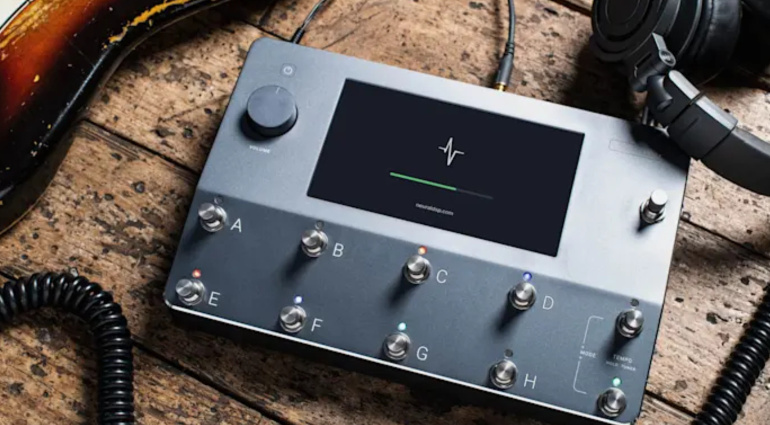



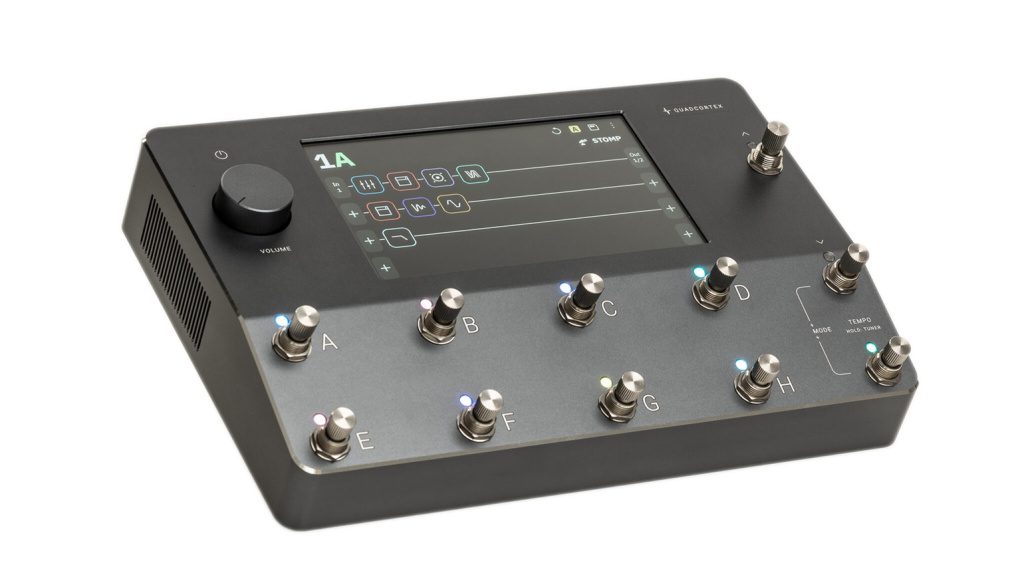
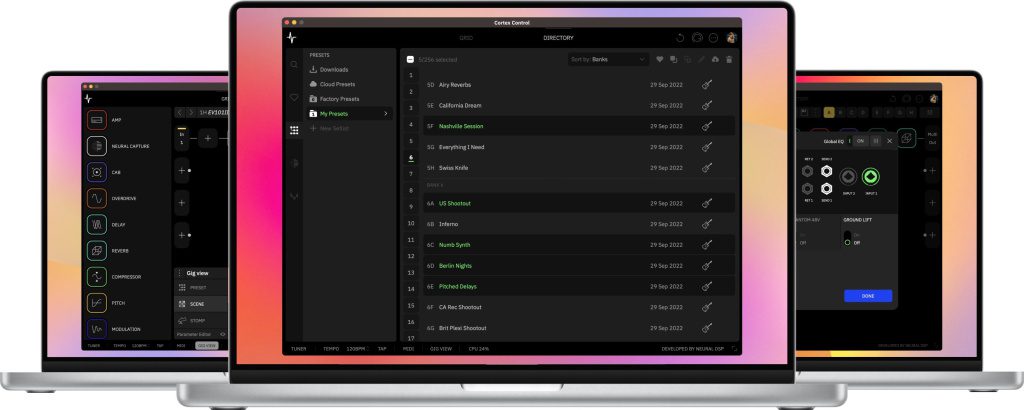
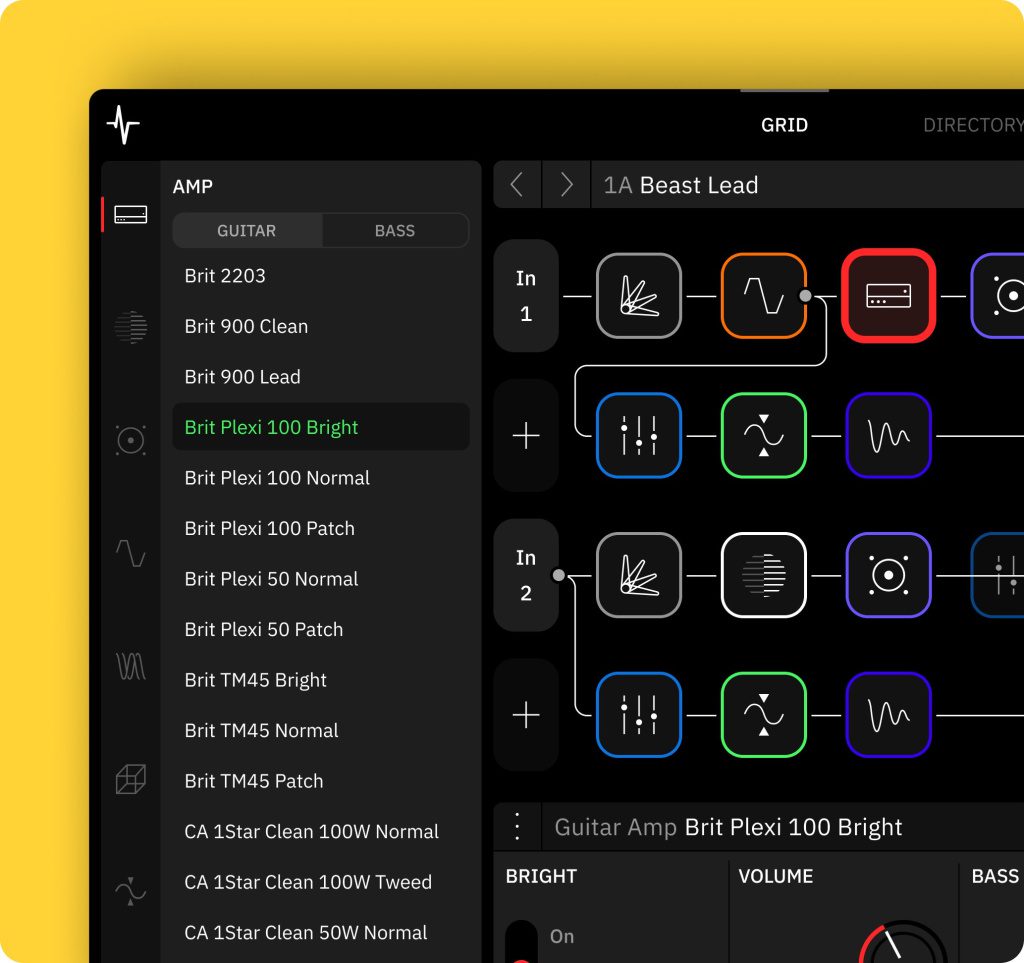
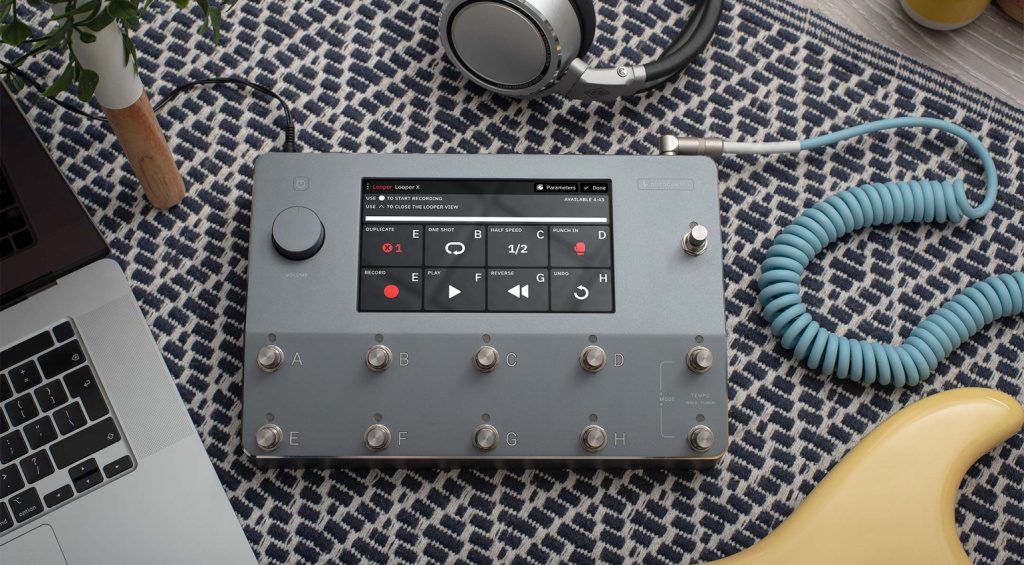
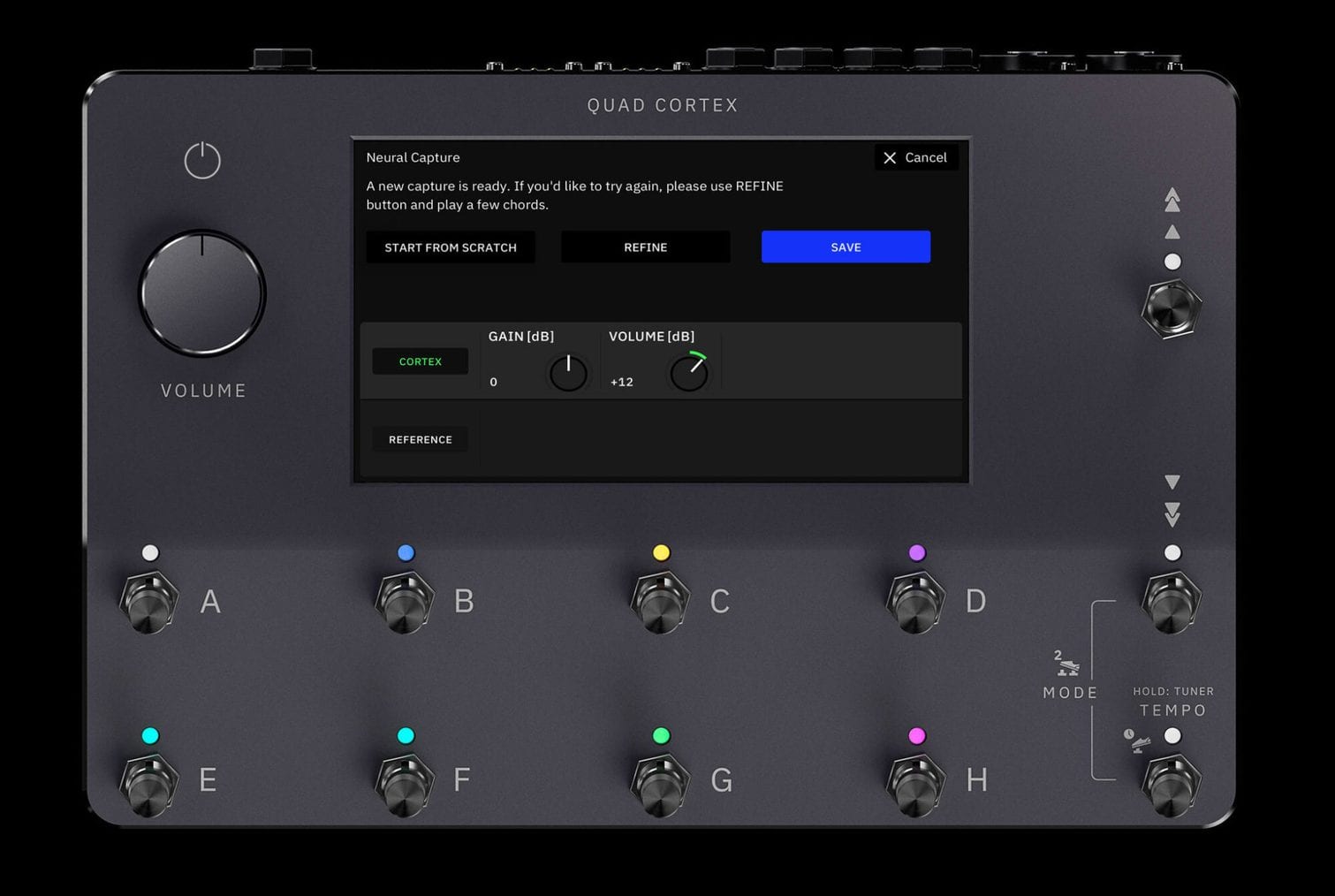
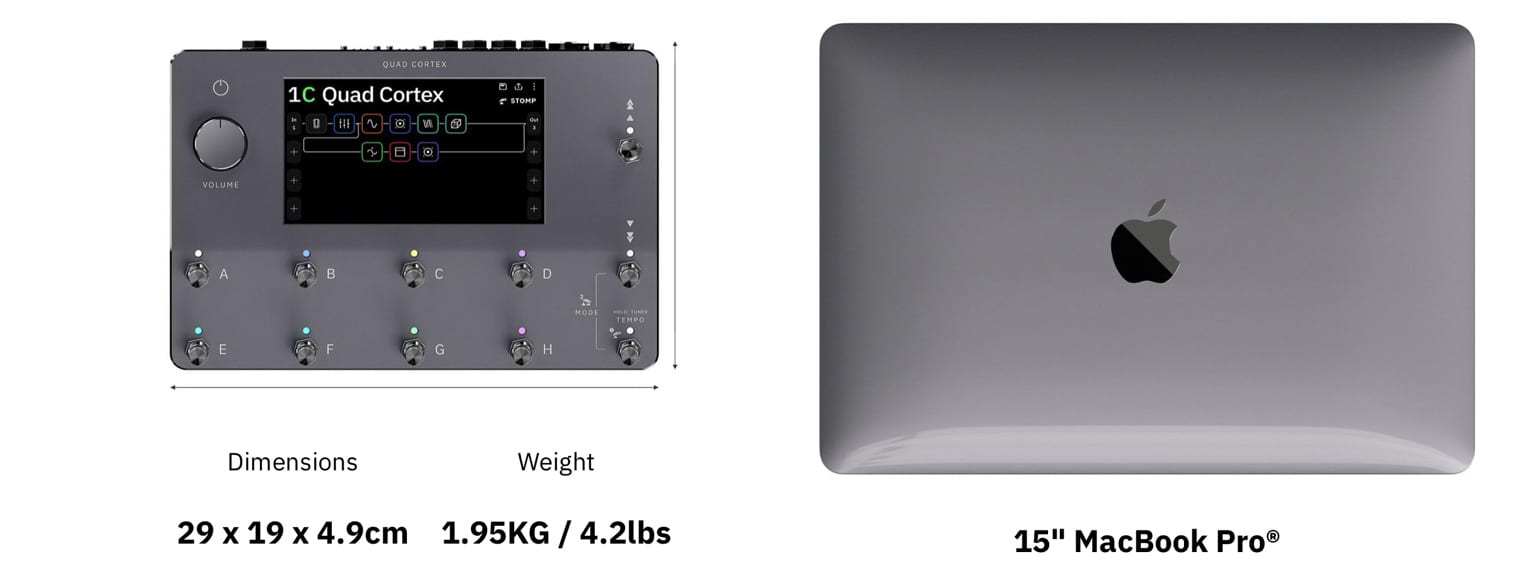
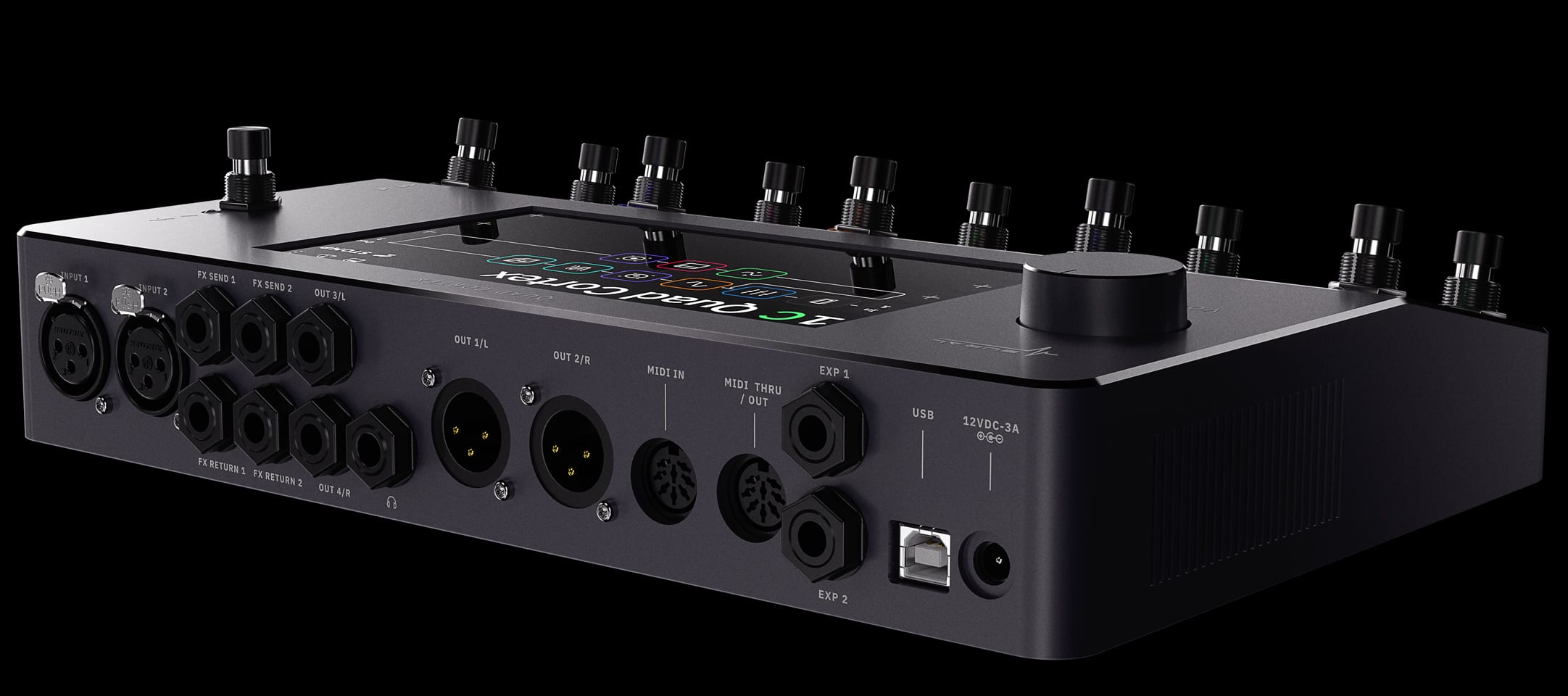
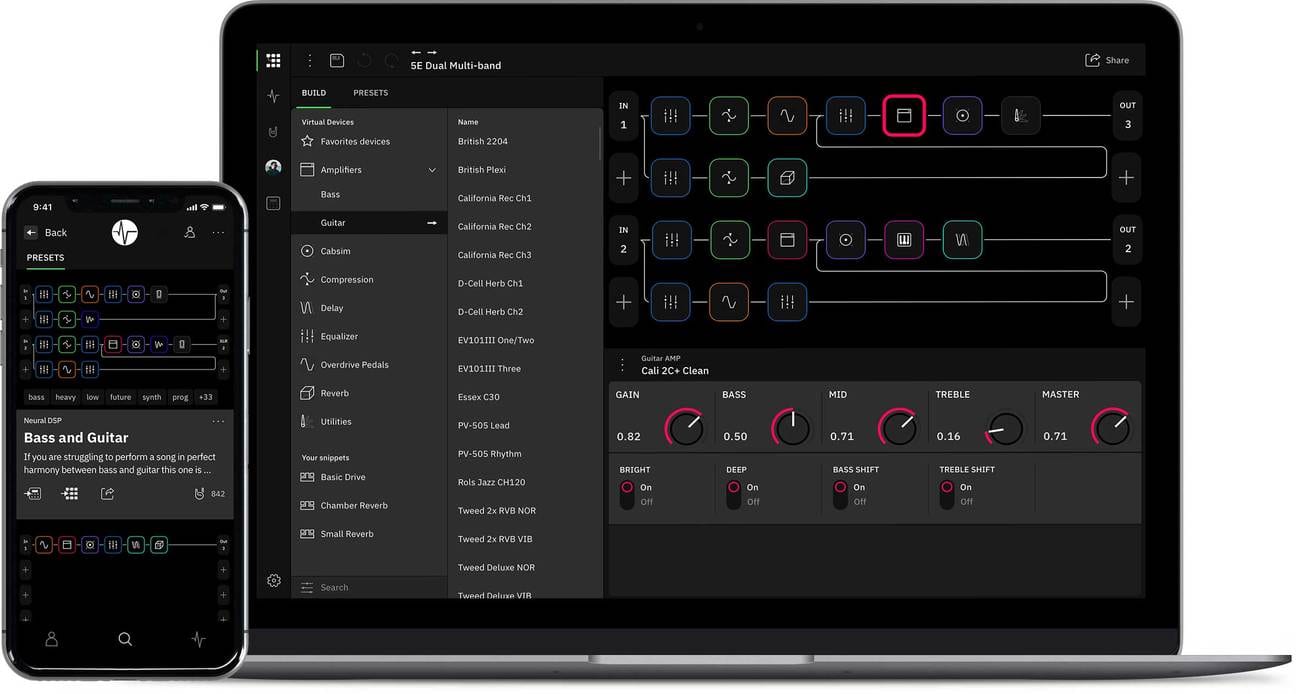
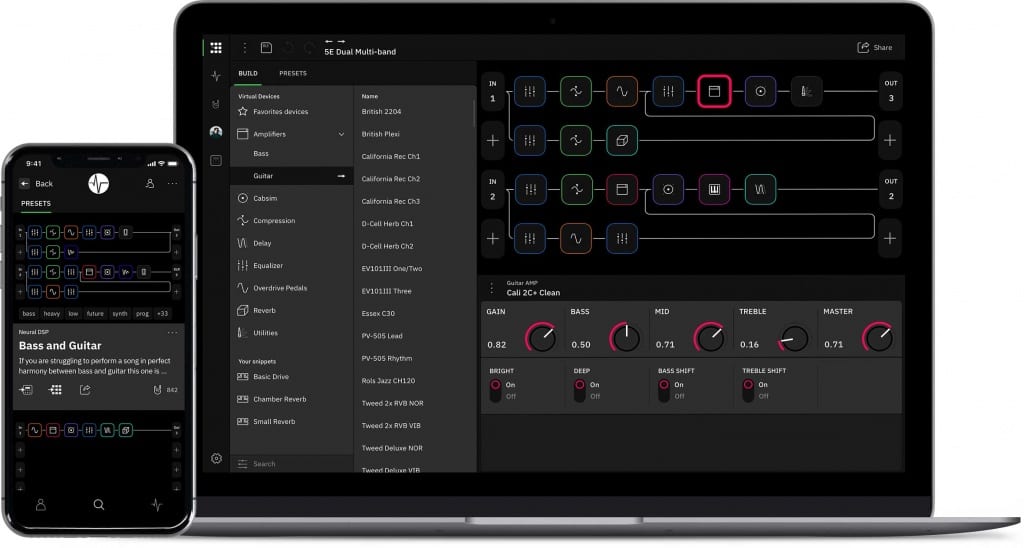
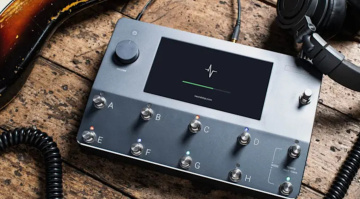

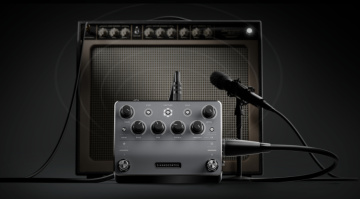
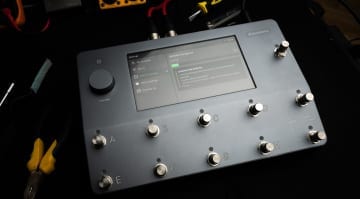
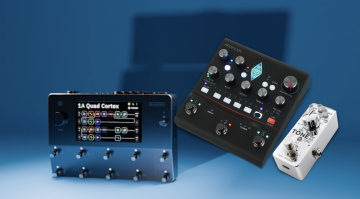

That only took a few years …
Too late, I already own a Tonex pedal and my Kemper Profiler pedal arrives Monday :)>